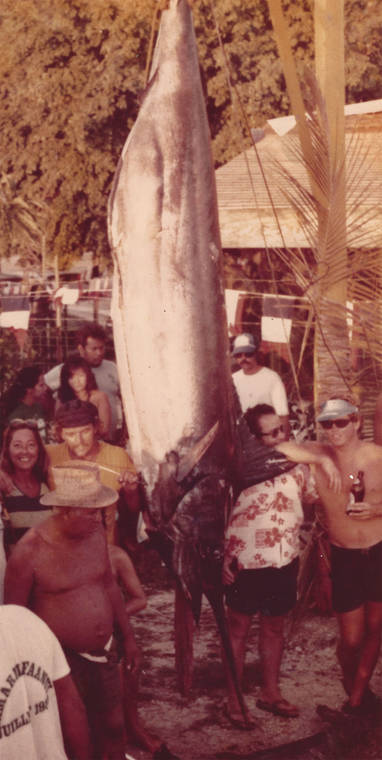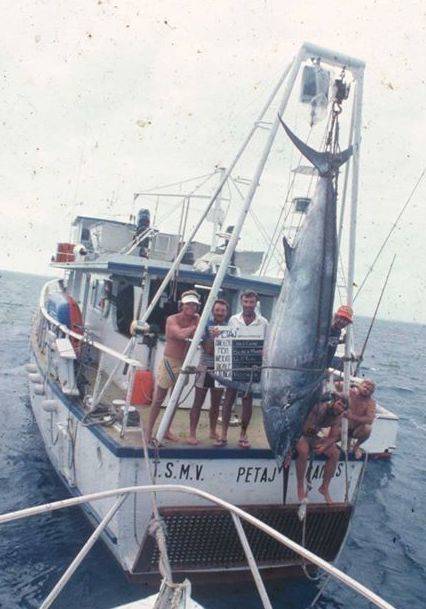The Bright Side: Do the math

The author with a blue marlin that measured out to be around 1,100 pounds out of Bora Bora in 1981. Why there is no “official weight” is a whole n‘other story. Notice here too, the marlin holds steady girth the length of the belly. The creases toward the tail are telltale signs of marlin close to or over 1,000 pounds. (Jody Bright/Special to West Hawaii Today)

Grander number 146 for Hawaii. Keith Hilton angler on Marlin Magic II with Capt. Marlin Parker and crew. Notice that the fish maintains girth the length of the belly. (Jody Bright/Special to West Hawaii Today)

The author in ancient times with one of two black marlin loaded on The Ark with Noah. They grabbed a weight of 1,289 pounds in transit. Notice how much bigger the girth is near the head than down the belly. (Jody Bright/Special to West Hawaii Today)
A news tip came through recently: a boat was bringing in a marlin that looked to be about 1,000 pounds. The coveted “grander.” When the fish weighed in south of that mark, the following story came to mind. And yes, it really happens.
A news tip came through recently: a boat was bringing in a marlin that looked to be about 1,000 pounds. The coveted “grander.” When the fish weighed in south of that mark, the following story came to mind. And yes, it really happens.
“Aw, mate. Fair dinkum! Have a squiz at that!” The grizzled old Aussie pointed up at the weigh scale in total disdain. “I thought we’d done a Bradbury but instead we got a dogs brekky. Mate, I’m spewin’!” This was a captain trying to console his angler, but when he went on in Strine, the American could only respond with a quizzical look.
The Yank was actually ecstatic, so he couldn’t understand why his skipper seemed to think that he should be upset. His eyes scanned the old salt’s face, looking for signs of mirth.
The skipper was not joking. He went on, “Only a stone shy of a grand. Totally devo, mate. Done the dash on this one.”
They had just weighed a behemoth of a black marlin, one that tipped the scales at 986 pounds and the captain said he was devastated. “I won’t hold ya as a grumblebum if you chuck a wobbly tonight!”
The yank had to laugh. “Captain, if you want me to, I’ll try to be disappointed. In fact, I can act so mad I won’t give you a tip.” The Aussie stopped spewing. “This is the biggest fish I’ve ever caught. If only 14 pounds stands between me and a grander, I’ll just tell 14 pounds worth of lies back home. As you say; I’ll make a bird of it.”
The old fox switched tactics. “Bob’s your uncle, Charlie. That’s the go! Sorry, I thought you’d been hit for six. Guess I lost the plot. We have 3 more days to add a stone to this beauty. Too easy, mate. We’ll give ‘em heaps!”
They were both laughing now. “Yeah, sure we will whatever you said Cappy.”
To most folks in the English speaking world, Australian slang is entertaining yet puzzling, while definitely unique. Between the slang and the accent, it’s common to wonder if you are actually sharing the same language while “down under.”
However, slang is just one of many things unique about Australia. No other place on earth has produced as many marlin over one thousand pounds. To an Aussie, having a fish miss the mark is an event worthy of lament.
To an American, this makes about as much sense as their slang. Outside of Australia, the odds of catching a fish that large are about the same as bagging a unicorn. If you even see one, it is an event worthy of whatever the opposite of lament is.
Hawaii is second to Australia in the number of granders caught, with 146. GBR historian Ray Joyce has counted up 718 black marlin weighed in over 1,000 pounds in Australia. Ray noted that there are an unknown number of granders weighed in over 1,000 that weren’t recorded, mostly from motherships at sea.
Black marlin can’t be sold in Australia so most fish these days — even granders — are caught and released. Many anglers weigh their first grander and then release the rest, unless much bigger. There are many veteran skippers still working the reef who were active in the days when every grander was weighed. When they call a released fish a grand, most guys nod and say, “Good on ya!”
However, there are active crews working today who have never put one on a scale. With catch and release the norm these days, the Catch Twenty Two is, “If you haven’t weighed one and haven’t seen one weighed, how would you know how to estimate one that swam away?”
Because of this, many veterans are “a bit suss” over the accuracy of those released and called a grand by the “young takkahs.” There are, however, a couple of ways you can get a decent estimate — sometimes. Taking simple measurements of a fish is best, but not always practical.
The formula used to extrapolate the weight of a marlin from measurements is: length X girth squared (in inches). Calculate that total, divide it by 750 and you should get pretty close to the weight of your marlin. Fish with the same girth measurement down the length of their belly may be bigger than what the formula says.
Experience says that its possible for a fish to be 1,000 pounds when it measures at least 138 inches from the tip of the lower jaw to the fork of its tail — and — 72 inches at the girth. That is a short measurement of 11 foot 6 inches and a girth measurement of 6 feet. The formula actually ciphers these measurements out to 953.85 pounds, a telling footnote on the accuracy of this formula.
Another method is to measure the circumference of the base of the tail of a marlin, which is always entertaining with a green crew and a live fish. It’s an oddity of nature, but marlin tails are pretty accurate. A tail measuring 19.5 inches indicates a fish around 950 pounds. A marlin with a tail of 20 inches is likely 1,000 pounds or more.
The fish mentioned in the beginning of this piece ended up weighing 898 pounds, When the tipster was asked how the rumor got out that it might be a grander, he replied that someone said that the short measurement needed to be only 134 inches to be a grand, the only measurement he knew of. If you do the math, a fish of 134 inches would have needed a girth of 76 inches to make a grand. Come to find that it was only 66 inches.
In Kona an old saying goes, “Don’t say it unless you weigh it.” The scale doesn’t lie. There are too many variables to call a fish just by length, and this example shows it. Even when you have good measurements, you could still be off.
Then it might be you hearing, “Aw mate. Too bloody bad. Two pounds shy of a grander!!”


